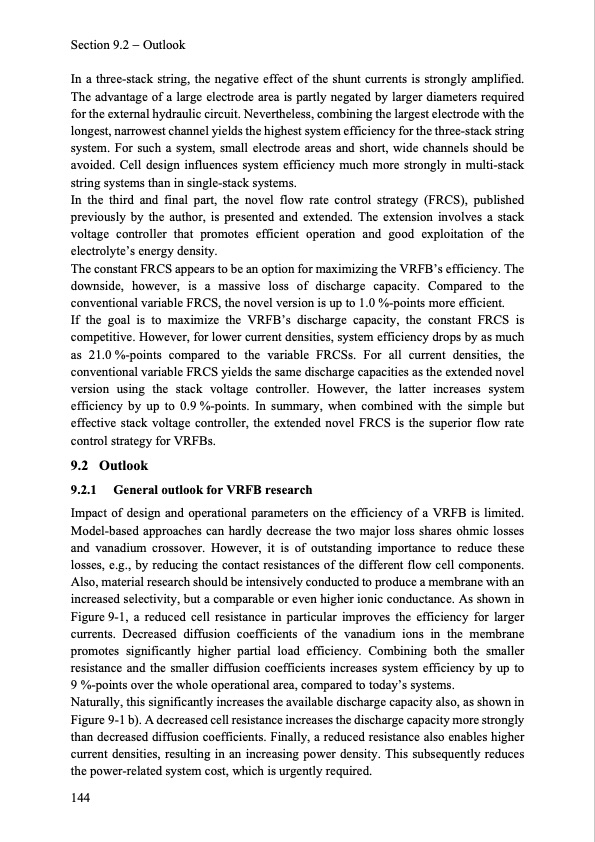
PDF Publication Title:
Text from PDF Page: 152
Section 9.2 Outlook In a three-stack string, the negative effect of the shunt currents is strongly amplified. The advantage of a large electrode area is partly negated by larger diameters required for the external hydraulic circuit. Nevertheless, combining the largest electrode with the longest, narrowest channel yields the highest system efficiency for the three-stack string system. For such a system, small electrode areas and short, wide channels should be avoided. Cell design influences system efficiency much more strongly in multi-stack string systems than in single-stack systems. In the third and final part, the novel flow rate control strategy (FRCS), published previously by the author, is presented and extended. The extension involves a stack voltage controller that promotes efficient operation and good exploitation of the electrolyte’s energy density. The constant FRCS appears to be an option for maximizing the VRFB’s efficiency. The downside, however, is a massive loss of discharge capacity. Compared to the conventional variable FRCS, the novel version is up to 1.0 %-points more efficient. If the goal is to maximize the VRFB’s discharge capacity, the constant FRCS is competitive. However, for lower current densities, system efficiency drops by as much as 21.0 %-points compared to the variable FRCSs. For all current densities, the conventional variable FRCS yields the same discharge capacities as the extended novel version using the stack voltage controller. However, the latter increases system efficiency by up to 0.9 %-points. In summary, when combined with the simple but effective stack voltage controller, the extended novel FRCS is the superior flow rate control strategy for VRFBs. 9.2 Outlook 9.2.1 General outlook for VRFB research Impact of design and operational parameters on the efficiency of a VRFB is limited. Model-based approaches can hardly decrease the two major loss shares ohmic losses and vanadium crossover. However, it is of outstanding importance to reduce these losses, e.g., by reducing the contact resistances of the different flow cell components. Also, material research should be intensively conducted to produce a membrane with an increased selectivity, but a comparable or even higher ionic conductance. As shown in Figure 9-1, a reduced cell resistance in particular improves the efficiency for larger currents. Decreased diffusion coefficients of the vanadium ions in the membrane promotes significantly higher partial load efficiency. Combining both the smaller resistance and the smaller diffusion coefficients increases system efficiency by up to 9 %-points over the whole operational area, compared to today’s systems. Naturally, this significantly increases the available discharge capacity also, as shown in Figure 9-1 b). A decreased cell resistance increases the discharge capacity more strongly than decreased diffusion coefficients. Finally, a reduced resistance also enables higher current densities, resulting in an increasing power density. This subsequently reduces the power-related system cost, which is urgently required. 144PDF Image | Model-based Design Vanadium Redox Flow Batteries

PDF Search Title:
Model-based Design Vanadium Redox Flow BatteriesOriginal File Name Searched:
10-5445IR1000070670.pdfDIY PDF Search: Google It | Yahoo | Bing
Salgenx Redox Flow Battery Technology: Salt water flow battery technology with low cost and great energy density that can be used for power storage and thermal storage. Let us de-risk your production using our license. Our aqueous flow battery is less cost than Tesla Megapack and available faster. Redox flow battery. No membrane needed like with Vanadium, or Bromine. Salgenx flow battery
| CONTACT TEL: 608-238-6001 Email: greg@salgenx.com | RSS | AMP |